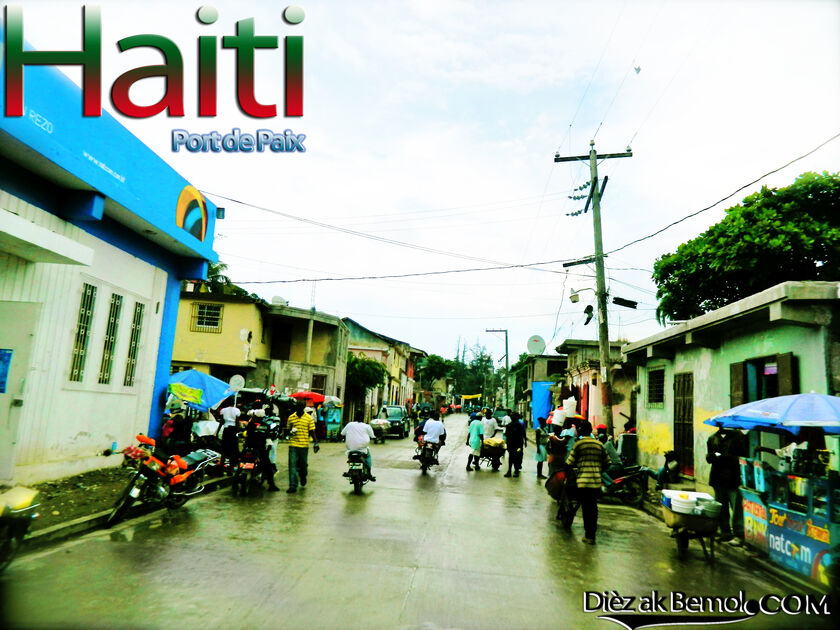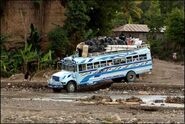"A country that can't feed it's people is condemned to be the servant of others."
Ansi Vixima, Tèt Kole Ti Peyizan peasant movement.
Port-de-Paix (Kreyól: Podpé, English: Port of Peace) is a city in Haiti's Northwest Department that is the cultural, financial, and political center of the northwest and its capital city. With a 2015 population of 194,045 it is the most populous city in the northwest and the eleventh-most populated city in Haiti.
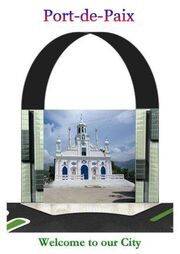
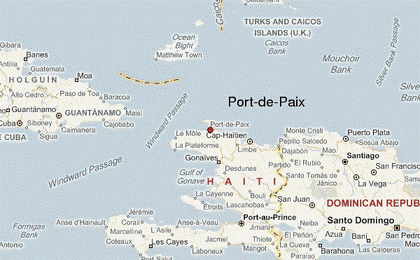
Location in Haiti
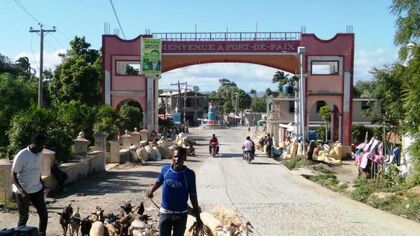
Welcome sign
Located in the center of the Cap-à-Foux coastline on the southern shore of Tortuga Channel, Port-de-Paix covers an area of 351.75 square kilometers (135.8 mi2). The city is also the seat of Port-de-Paix Arrondissement and the main component of the Cap-à-Foux region, colloquially referred to as the "Far West". The city is close to the mouth of the river Trois-Rivières, one of the most important rivers in Haiti. A ferry operates between there and Tortuga Island, situated just across the water. Tortuga Island and Port-de-Paix are Haiti's northernmost communes.
About[]
Port-de-Paix is notable for its fertility, abundance of rain, numerous rivers, and the superior intelligence and industry of its inhabitants. It has a good harbor in front and fine rich country behind it. Its pleasant landscape and dazzling white sand beaches sparked Christopher Columbus to adopt the name "Valparaiso" (Valley of Paradise) in 1492. The city also owes its former name to the fertile Trois-Rivières Plain. Major agricultural products including coffee, tobacco, peppers, and cocoa maintain their origins in the Port-de-Paix region. Because the city is so accessible to the US via the Atlantic, trade has developed into making Port-de-Paix one of the biggest exporters of bananas and coffee. Bertrand d'Ogeron planted the island's first cocoa tree there. Governor de Cussy established the capital of the French colony there.
Origins[]
Before the arrival of the Spanish, the area around Port-de-Paix was inhabited by the Arawak nation of the Taíno peoples of the Caribbean. The town was founded in 1632 by Frederick Deschamps de La Place, the second governor of La Tortue (Some records place this date as 1644). It was founded as Valparaiso on the former residence of a lieutenant of the ancient province of Marién. But it quickly gave way to French pirates, on whom Louis XIV and Colbert relied on to impose French influence on the region. From the 1640s, Port-de-Paix, along with Turtle Island, was one of the first bases of French presence on the west side of Hispaniola.
The French pirates, driven out of Tortuga Island by English and Spanish pirates, landed in the area in 1665. This was their second establishment on the great land. They found a rest without anxiety and called it "Port-de-Paix".

Bertrand d'Ogeron c.1650
After 1665, Bertrand d'Ogeron de la Bouere, governor of La Tortue, stimulated the development of Port-de-Paix by encouraging the pirates to become farmers. This movement was reinforced by the arrival of hundreds of recruits (called "36 months", the duration of their contract) whom Ogeron brought from France. Gradually, they settled down and the cultivation of cash crops took off. The region's fertility also enticed the importation of more and more slaves from Africa.
In 1666, d'Ogeron planted cocoa trees found by Columbus on an island in Honduras Bay. They flourished for over half a century. In 1685, Pierre-Paul Tarin de Cussy, governor of Saint-Domingue, settled in Port-de-Paix, making it the first official capital of the French colony of Saint-Domingue. The city became the center of gravity of the French prescence on the Island of Hispaniola. In 1688, about 50 French soldiers settled here. In July 1695, Port-de-Paix was attacked and pillaged by the English in retaliation for the expedition to Jamaica the year prior, led by Jean-Baptiste du Casse.
In 1812, the city was granted municipal status. In the old days of the Spanish, it was called Valparaiso. After the departure of the Spaniards in favor of many changes that have taken place, it adopted the name of "Port-de-Paix" which it has preserved to this day.
History[]
Nicknamed Valparaiso "Valley of delights" by Christopher Columbus, the area of Port-de-Paix entered the historical record in 1492. The French, who had settled Saint-Domingue during the 1600s, made Port-de-Paix its capital after they had been ousted from Tortuga Island by the British. In 1679 Port-de-Paix witnessed the initial black slave uprising, which was to last a decade.
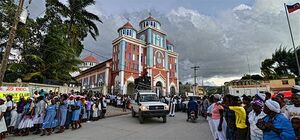
Cathedral of the Immaculate Conception in Port-de-Paix
• Under the regime of Pouancey, successor of Ogeron, in 1679, the first revolt of ebony slaves led by Padrejean, a Spanish black, broke out at Port-de-Paix. Port-de-Paix must be proud of having engendered this first spark of liberty. Unfortunately, this revolt was stifled by the buccaneers.
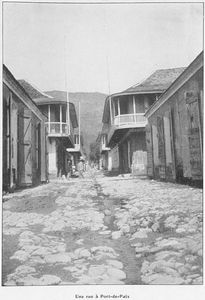
Port-de-Paix
• In 1685, the buccaneers thought of transferring the seat of the colonial government to Port-de-Paix.
• In 1695, 6,000 English took possession of Port-de-Paix over from French. M. Ducasse, then governor, presented them with such a threatening attitude that they withdrew, but laden with booty.
• In 1772 a hurricane redecorated almost all the city, which nevertheless recovered with time, but it was ravaged again at the arrival of the Leclerc expedition in 1802, by the intrepid Maurepas, who defended it with a great deal of bravado.
• In 1793 during the proclamation of the general liberty of the slaves, the workshops of Port-de-Paix, as well as their products, were lost by the colonists.
• In February 1794, Governor Laveaux expelled the English, who blocked the city by sea, and the Spaniards on the ground: Withiloke, the English commander, seized and reached the Turtle Canal. It was time: the city was in the most terrible misery.
• It was at Port de Paix that Toussaint Louverture joined the French, and that he made his submission, in 1794, to Governor Laveaux, with 5,000 men, after having abandoned the Spanish. Laveaux received him with the greatest distinction, and appointed him general of brigade.
• On September 10, 1796, Danty, chief of brigade, was executed at Port-de-Paix.
• While Toussaint's army was occupied fighting Riguad at Grand-Goâve, at the beginning of the civil war, in 1799. lieutenant colonel Golard raised the farmers of Port-de-Paix, Jean-Rabel, and Bombarde. Golard, at the head of several millions of men, came to attack the city or command Colonel Maurepas. The city was reduced in a few days to the last extremities. Maurepas exhibited the greatest courage, held an admirable course, and resisted on all points the incessant efforts of the insurgents. He made several happy outings. General Moise came to chase the insurgents.
• 1803 is noted for Port-de-Paix being the last place evacuated by the French.
• The valiant Colonel Rebecca shook the yoke of King Christophe in May 1807, at the head of the 9th regiment of infantry to submit to the Republic of Pétion, which resulted in the expedition of an army at Mole St. Nicolas under the orders of General Lamarre. To honor his memory, the Senate has paid a pension to the widow and mother of Jean Louis Rebecca.
• Its first church was covered in 1820. The cathedral was overthrown on September 23, 1887 during the earthquake. The population has returned to the task, and March 4, 1888 the first stone of the new cathedral was placed on the site of the old church reversed in 1842. A historical document here is the act of foundation filed under the stone in question.
By the 19th century, Port-de-Paix was prospering. However, in 1902 a fire broke out and raged through the city, completely demolishing it. Since that time, it has never made a full recovery.
• In 1899, Port-de-Paix was an object of interest for a proposition looking to construct a railway southward through the valley of the Trois-Rivières to Gros-Morne to connect by an offshoot with a road projected to run through the great central plain of the Artibonite.
• In August 1915, during the American occupation, the Cacos came in bands to plunder the city of Port de Paix, which they knew was disarmed. The inhabitants paid their dues and gave them a few hundred gourds to save their city from plunder. The Cacos withdrew, promising to return soon. But the inhabitants of the city called from Cap-Haïtien the Americans who came to seize the city to protect it from the Cacos.
• On June 12, 1918, the population approved the Dartiguenave constitution by 2481 "yes" votes.
• On the night of April 3 to 4, 1919, a large fire broke out in Port-de-Paix at 3 o'clock.
• On May 27, 1924, at quarter past four, a strong earthquake was felt.
• In 1925, under President Borno, the l'Ecole des Soeurs and the Hospital were built. Work on the Gros Morne Port-de-Paix road was completed.
Geography[]
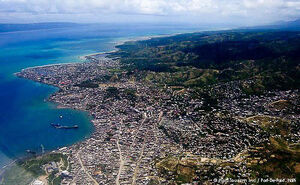
Port-de-Paix aerial
Located roughly midway between Cap-Haïtien and Môle Saint-Nicolas, Port-de-Paix is a coastal city adjacent to Canal de la Tortue. Its shoreline extends in the shape of a crescent from Petit-Fort, to the northeast near Morne-aux-Pères, to Grand-Fort to the northwest.
The city, situated at 19.9349° N, 72.8309° W, is lined by streets whose directions vary because of the fact that the city follows the curve which is defined by the shore. According to the IHSI, the commune has a total land area of 351.75 square kilometers (135.81 square miles), of which 312.67 Sq.km (88%) is rural, 31.26 Sq.km (9%) is suburban, and 7.82 Sq.km (3%) is urban.
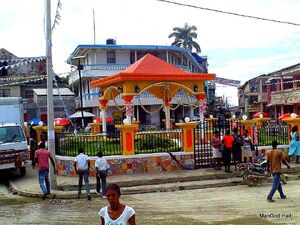
Colorful Port-de-Paix
It has seven communal sections. It is bordered on the east by the towns of La Pointe and Chansolme, on the southeast by the town of Bassin-Bleu, on the south by the Artibonite town of Anse-Rouge, and on the west by the town of Jean-Rabel.
The land area of the commune consists of hills, plateaus, and plains. The commune has a tropical savanna climate, characterized by dry winters, with the most precipitation occurring in the fall. The air quality is at times compromised because of the swamps that surround the city. The mountains of this commune contain iron; they are productive trees in coffee, commodities and food supplies; the most beautiful artichokes of the country grow here. The climate in the mountains is very favorable to health.
The city
The urban fabric of Port-de-Paix presents the same characteristics of colonial towns with an original checkerboard pattern which, as it evolves, spreads in a sprawling form in a spontaneous manner with no planning or layout. Thus the extensions of the city of Port-de-Paix are oriented towards the coast or towards the mountains, defying the environmental risks presented by the site. The main streets of the city are Stenio Vincent, Notre-Dame (towards the wharf), du Quai, Rue Benito Sylvain, and Capois.
Demographics
The inhabitants of the commune are called Port-de-Paisien/ne.
| Year | Population | +/- |
|---|---|---|
| 1890 | 25,900 | |
| 1950 | 40,573 | +57% |
| 1970 | 10,753 (est.) | -74% |
| 1975 | 21,733 | +106% |
| 1988 | 135,374 | +523% |
| 1998 | 105,767 | -22% |
| 2003 | 120,267 | +14% |
| 2004 | 121,000 | +1% |
| 2015 | 194,045 | +60% |
Neighborhoods
| PDP | Port-de-Paix | 194,045 | |||
|---|---|---|---|---|---|
| VPX | Ville de Port-de-Paix | Urban | 121,220 | ||
| BAU | 1ère Section Baudin | Rural section | 13,287 | Bras Homme, Daudin, Grand Etang (Ou Déroulin), La Croix, Lallemand, La Pointe, Madelon, Nan Dubuy, Nan Masse, Trois Pavillons. | |
| Separated from Port-de-Paix in March 2015. | |||||
| AUB | 3ème Section Aubert | Rural section | 9,685 | Aubert, Bois Rouge, Cachina, Deux Mélisses, La Coupe, La Tendrie, Mare Denis, Petit Etang, Polvo | |
| MAH | 4eme Section Mahotière | Rural | 25,603 | Atraille, Bananier, Bangouinyote, Bas Mahotière, Beauchamp, Cléante, Fond Dubois, Gerbe-à-Flèche, Grand Fond Ti Noël, Gros Cajou, Jourdin , Mahotière, Marc Caluc, Michel, Nan Aimé, Nan Coton, Nan Coucou, Nan Couteau, Nan Gouine, Nan Maillette, Nan Palmiste, Nan Roche, Quisa, Raymond, Saline Maillette. | |
| BAM | 5eme Section Bas des Moustiques | Rural | 13,726 | Bambou la Selle, Bananier Colas, Bombay, Calebassier, Chérubin, Danda Caillo, Desjardin, Digoterie, Figue banane, Foison, Fond Farde, Fond Ti Bonheur, Fond Ti Cousin, La Carrière, Les Fonds, Manvion, Mare Plate, Nan Cocoyé, Nan Rémy, Passe Catabois, Piton Mouri, Poste Métier, Roche Couteau, Rosette, Ti Charles, Ti Cousin, Zeb à flèche. | |
| LCN | 6eme Section La Corne | Rural | 10,524 | Audrouin, Bois Milot, Cordier, Ford Coq, Haut Fourneau, Jean Denis, La Saline, Nan Jean Louis, Paulin, Terre Brûlée. |
Economy[]
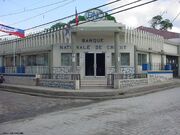
Local bank
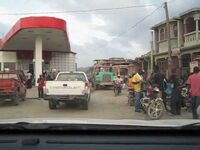
The local economy is largely based on trade. Commercial exchanges usually consist of the sale of food products and household items. Traders buy their products in cities such as Port-au-Prince, Ouanaminthe, Nassau, or Miami.
The port is one of the city's main centers of activity. Port-de-Paix has a reputation as a city geared towards foreign trade, which attracts a flow of activities. However, this port falls short of meeting the requirements and standards of the ISPS Code (International Code for the security of ships and port facilities).
Port-de-Paix's marketplace is an extension of the port which, in principle, constitutes its main source of supply. On the other hand, the layout of the city market poses a problem. This occupies a good part of the city center thus causing traffic jams which pose a major challenge for sanitation.
With regard to economic and financial establishments, the commune of Port-de-Paix is better equipped than the others. It has three banks, several hotels and restaurants, two home centers, and a marketing cooperative.
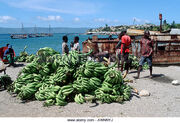
Bananas prepared for export
A rich agricultural area, it grows coffee, bananas, tobacco, rice, and cacao. Its proximity to the U.S. via the Atlantic permits a smuggling trade which has flourished since the 1990s.
Its soil contains silver, iron, copper, tin, zinc, sandstone, chalk, alabaster, mineral springs in the Cuivrière, and a curious cave called Trou du Bon Dieu; it also produces the cactier, the nopal, garlic, shallot, mahogany, the latanier and abenier in the Mosquitos section. The Port de Paix cafe ranks third on the major European markets. Its forests feed wild guinea fowl, other rare birds and wild boar from the West Indies.
The coasts are very full of fish. The Trois Rivières River, after crossing Plaisance and Gros-Morne, flows into the bay of Port de Paix after a journey of 35 leagues.
Infrastructure[]
Transportation
Port-de-Paix's transportation infrastructure is well developed, being served by many regional airlines. They offer flight service from Port-de-Paix Airport to Toussaint Louverture International Airport, located in Port-au-Prince, and to Cap-Haitien International Airport in Cap-Haïtien. A ferry operation carries tourists between the beautiful beaches of Port-de-Paix and Tortuga Island.

Without a structured intra-urban transport system, motorcycle taxis are the main alternative when it comes to getting around town.
Cramped streets, some of which are in dirt condition, are transformed into veritable swamps or dusty areas depending on the season. This is due, in large part, to the fact that the various watersheds overlooking the city are in clear degradation due to the anarchic occupation of the hillsides, on the one hand and, on the other hand, the uncontrolled cutting of trees making up the flora.
Education

Lycee Local High School
The Ministry of National Education is represented by a departmental directorate. There are five private kindergarten and primary schools, 11 public schools, numerous private, and 6 congregational. For the secondary level there are two Public Schools numerous private schools and a Congregational School.
Healthcare
The Ministry of Public Health and Population is represented by a departmental directorate. For health care facilities there are two non-bed health centers, two hospitals, 13 clinics and three medical laboratories. In addition, a team of doctors, dentists, nurses, auxiliaries, many certified matrons and a dozen laboratory technicians, provide the health service at the various health centers of the municipality.
Utilities
As for water availability, five rivers, two dozen Springs and a pond were inventoried. For the other water points, eight artesian wells, public fountains with at least 25 taps and also three pumps were recorded. The water coming from the public fountains is the most used. It is used for domestic use and especially for drinking. For electricity, a large part of the commune is electrified. The HRE is the institution responsible for electricity in this commune. It provided an average of 56 hours/week.
Security
With regard to administrative and judicial infrastructures, the commune of Port-de-Paix has a peace court downtown at Rue Dumarsis-Estime. There is also a prison.
Culture[]
The city is located on the ocean front so one of the first noticable things is all manner of boats on the water, both for fishing and for transporting goods and people back forth between Ile de la Tortue. Port-de-Paix is a busy city of helpful people. There is a lot of music and people like to have a good time. People are generally fond of Americans. Most people are religious and there are many churches. It is easy to get around with even just a few words of Kreyól.
Religion
With respect to Religion, more than 100 temples of all faiths were counted in the commune of Port-de-Paix. These confessions are: Catholics, Adventist, Baptists, Pentecostal and Jehovah's Witnesses. The number of Pentecostal temples and churches of God is better represented are 44% of the total.
Organizations
With regard to the political parties and organizations that have gone through the city and the communal sections, there are seven political parties, 34 popular organizations, six peasant groups, thirteen Women's groups, three non-commercial cooperatives, six NGOs and four International organizations.
There are some micro-credit lending institutions here such as Fonkoze, COPLES, and ACLAM (supported by World Concern)
Communication
In terms of Communication, the municipality of Port-de-Paix has no "newspapers/journals" but has seven radio stations and a television station.

Woman in Port-de-Paix
In Port-de-Paix, radio stations abound, many of them FM, and a few broadcast over the Internet. Fans of Compás in Port-de-Paix favor such music artists as Shoubou de Tabou Combo, Cubano de Skah Shah, and Drumcp.
Leisure
As for leisure, the gaguères, numbering six, constitute the main places of distraction for the inhabitants of the commune. For other types of entertainment, four football (soccer) fields, two basketball courts that are in deflated condition, a theatre room and six night clubs have been inventoried at the level of this municipality.
In terms of places to stay, the hotels are mostly along the waterfront. One of the most popular is the Rendez Vous, as it is on the water, clean, and has a bar and a restaurant. Other lodgings include the Hotel Holiday or the Hotel de La Paix.
Points of interest
• Baie des Moustiques where Christophe Colomb planted his cross
• Cascade de Chansolme
• Fort des Trois Pavillons (near Port-de-Paix) which recalls the heroic resistance of Maurepas to the troops of Leclerc.
• The Trou Don Dieu and Jumelle caves
Twin towns and Sister Cities[]
Port-de-Paix is a twin city of Oakland, California, USA, as recognized by Sister Cities International.
Notable Residents[]
Francois Capoix, hero of independence, also known as Capoix-La-Mort
Tertullien Guilbaud, a famous poet, whose name is the namesake of the city's main high school.
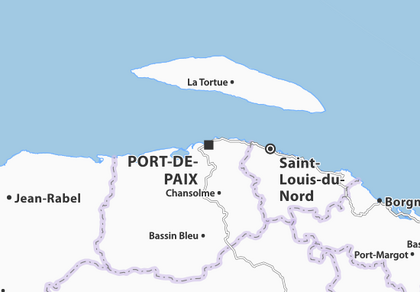
Area map
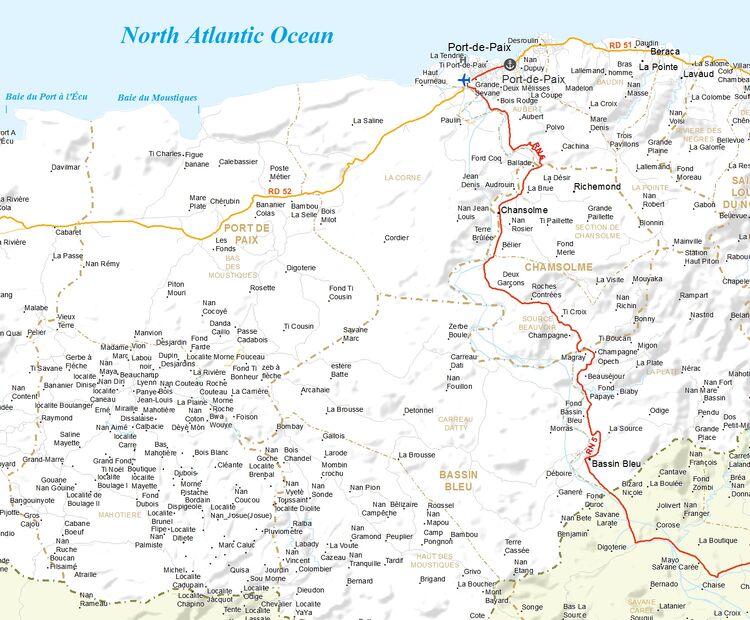
Michael Vedrine
References[]
Cuba and Porto Rico: With the Other Islands of the West Indies : Their Topography, Climate, Flora, Products, Industries, Cities, People, Political Conditions, Etc - Robert Thomas Hall [2]
The history of the city of Port-de-Paix in 7 key dates -Loop News
Plan spécial de Port-de-Paix - Secretariat generale de la Primature [4]
Présentation de la ville - WordPress [5]
Port de Paix: Past, Present, and Potential - Bryan, Haitian Innovation [6]
Profil de la ville de Port-de-Paix - Haiti Reference.info [7]


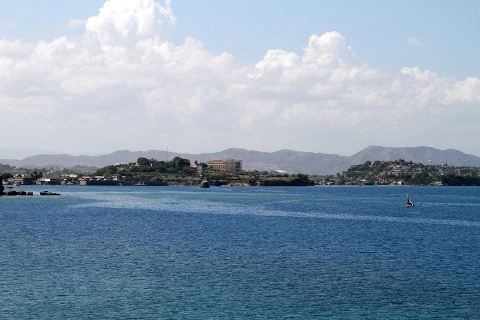

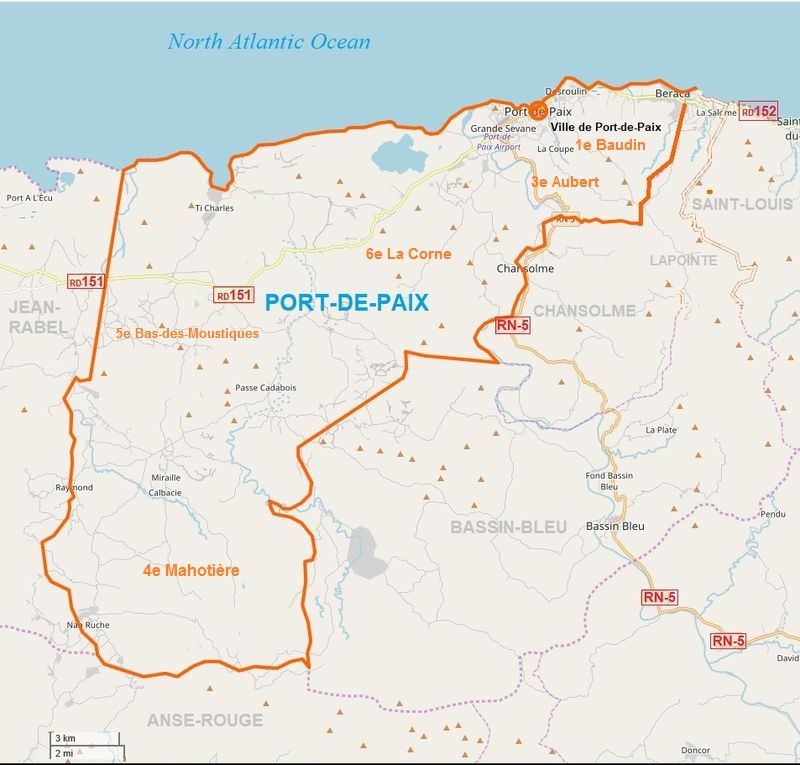
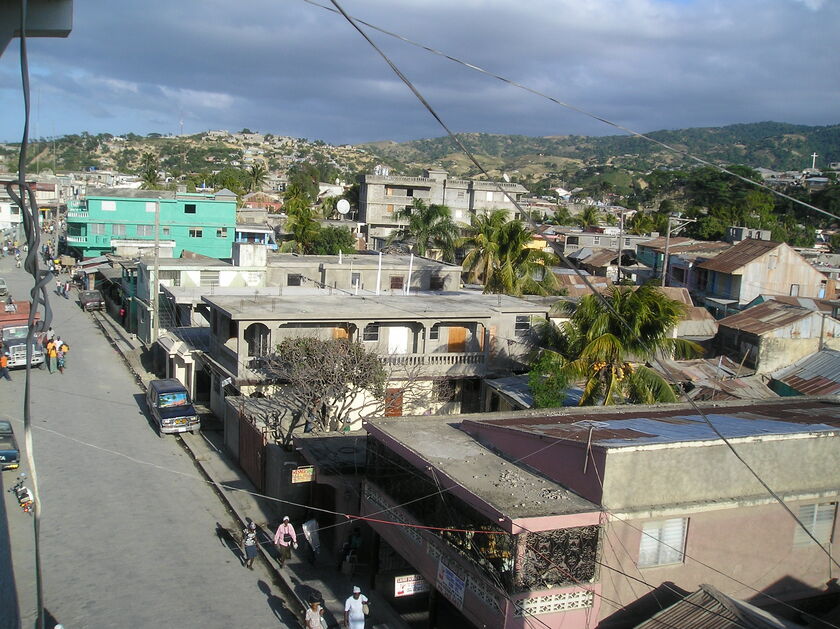

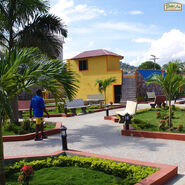
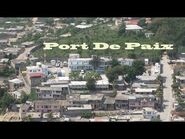

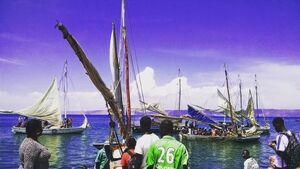


![Pdp30.jpg (126 KB) Port-de-Paix Airport [1]](https://static.wikia.nocookie.net/haiti/images/5/5f/Pdp30.jpg/revision/latest/scale-to-width-down/185?cb=20171027003958)
